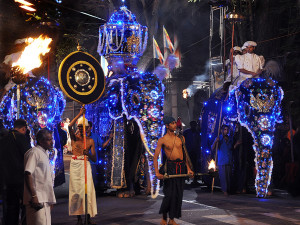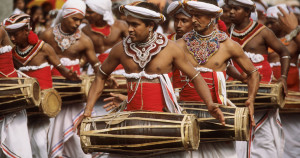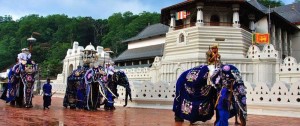Vesak is recognised as the most venerated day of the calendar for all Buddhists in Sri Lanka, Bangladesh, India, Nepal and the South East Asian countries of Singapore, Vietnam, Thailand, Cambodia, Laos, Malaysia, Burma, and Indonesia. This day encompasses the three main life events of Gautama Buddha namely as birth, enlightenment and passing away. All cities and villages celebrate Vesak colourfully following the traditional arts and crafts. Colombo, as the capital of Sri Lanka organises the Budhdha Rashmi National Vesak Festival 2016 to be held on 21, 22, 23, 24 and 25th May 2016 in historic Gangarama temple, prestigious temple trees and surroundings of serine Bere Lake. The temple's architecture demonstrates an eclectic mix of Sri Lankan, Thai, Indian, and Chinese architecture. This Buddhist temple includes several imposing buildings and is situated not far from the placid waters of Beira Lake on a plot of land that was originally a small hermitage on a piece of marshy land. It has the main features of a Vihara (temple), the Cetiya (Pagada) the Bodhitree, the Vihara Mandiraya, the Seema malaka (assembly hall for monks) and the Relic Chamber. In addition, a museum, a library, a residential hall, a three storeyed Pirivena, educational halls and an alms hall are also on the premises. Most notable for tourists is the architecture of the Simamalaka Shrine, which was built with donations from a Muslim sponsor to the design of Geoffrey Bawa. Today Gangaramaya serves not only as a place of Buddhist worship; it is also a centre of learning. The temple is involved in Buddhist welfare work including old peoples' homes, a vocational school and an orphanage. The temple is uniquely attractive and tolerant to congregation members of many different religions. Among various colourful events in this temple, the Vesak lantern and pandal competition is

Vesak is recognised as the most venerated day of the calendar for all Buddhists in Sri Lanka, Bangladesh, India, Nepal and the South East Asian countries of Singapore, Vietnam, Thailand, Cambodia, Laos, Malaysia, Burma, and Indonesia. This day encompasses the three main life events of Gautama Buddha namely as birth, enlightenment and passing away.
All cities and villages celebrate Vesak colourfully following the traditional arts and crafts. Colombo, as the capital of Sri Lanka organises the Budhdha Rashmi National Vesak Festival 2016 to be held on 21, 22, 23, 24 and 25th May 2016 in historic Gangarama temple, prestigious temple trees and surroundings of serine Bere Lake.
The temple’s architecture demonstrates an eclectic mix of Sri Lankan, Thai, Indian, and Chinese architecture. This Buddhist temple includes several imposing buildings and is situated not far from the placid waters of Beira Lake on a plot of land that was originally a small hermitage on a piece of marshy land. It has the main features of a Vihara (temple), the Cetiya (Pagada) the Bodhitree, the Vihara Mandiraya, the Seema malaka (assembly hall for monks) and the Relic Chamber. In addition, a museum, a library, a residential hall, a three storeyed Pirivena, educational halls and an alms hall are also on the premises. Most notable for tourists is the architecture of the Simamalaka Shrine, which was built with donations from a Muslim sponsor to the design of Geoffrey Bawa.

Today Gangaramaya serves not only as a place of Buddhist worship; it is also a centre of learning. The temple is involved in Buddhist welfare work including old peoples’ homes, a vocational school and an orphanage. The temple is uniquely attractive and tolerant to congregation members of many different religions.
Among various colourful events in this temple, the Vesak lantern and pandal competition is highlighted and very popular among the public. In Vesak Season in electrically lit Vesak pandols called thoranas are erected island wide at public places, being mostly sponsored by donors, religious societies and welfare groups. Each pandol illustrates a story from the 550 ‘Jathaka Katha’ or the 550 Past Life Stories of the Buddha.
Vesak lanterns called Vesak koodu are lit in most of the homes in Sri Lanka on Vesak poya day. The lighting signifies an offering to the memory of the Buddha who delivered the message of Dhamma. In ancient times, people used their clay oil lamps for illumination. When candles became popular, colourful lanterns were made in different shapes and colours were used. Buddha Rashmi Vesak Kalapaya arrange competitions on Vesak lanterns with the creators of the most beautiful lanterns being awarded valuable prizes.

During this week, the selling of alcohol and flesh is usually prohibited, with abattoirs also being closed. Celebrations include various religious and alms giving activities. Electrically lit pandals called Toranas are erected in various locations mainly in Colombo, Kandy, Galle and elsewhere; most sponsored by donors, religious societies and welfare groups. Each Pandal illustrates a story from the 550 Jataka Katha or the 550 Past Life Stories of the Buddha. The Vesak Pandal depicting various Jathaka stories with paintings are erected all over Sri Lanka. They are illuminated and presented beautifully.

Food stalls set up by Buddhist devotees called Dansalas provide free food and drinks to passers-by. Groups of people from various community organizations, businesses and government departments sing Bhakti gee or Buddhist devotional songs. Colombo experiences a massive influx of public from all parts of the country during this week. The Vesak festival marks the birth, enlightenment and passing away into Nirvana of the Lord Buddha and includes devotion and Alma giving with spectacular displays and entertainment. The weeklong celebration gives the visitor a unique opportunity to discover Sri Lanka’s religious and cultural traditions. Lanterns made from bamboo frames and covered in coloured paper are hung inside every home and incredible illuminated displays decorate the streets. There could be no Vesak without lanterns and Vesak lantern competitions are organise in a number of cities and towns. The winners are awarded valuable prizes.
On Vesak day, devout Buddhists and followers alike are expected and requested to assemble in their various temples before dawn for the ceremonial, and honourable, hoisting of the Buddhist flag and the singing of hymns in praise of the holy triple gem: The Buddha, The Dharma (his teachings), and The Sangha (his disciples). Devotees may bring simple offerings of flowers, candles and joss-sticks to lay at the feet of their teacher. These symbolic offerings are to remind followers that just as the beautiful flowers would wither away after a short while and the candles and joss-sticks would soon burn out, so too is life subject to decay and destruction.
Devotees are enjoined to make a special effort to refrain from killing of any kind. They are encouraged to partake of vegetarian food for the day. In some countries, notably Sri Lanka, two days are set aside for the celebration of Vesak and all liquor shops and slaughter houses are closed by government decree during the two days. Also birds, insects and animals are released by the thousands in what is known as a ‘symbolic act to liberation’; of giving freedom to those who are in captivity, imprisoned, or tortured against their will. Some devout Buddhists will wear a simple white dress and spend the whole day in temples with renewed determination to observe the eight Precepts.
Devout Buddhists undertake to lead a noble life according to the teaching by making daily affirmations to observe the Five Precepts. However, on special days, notably new moon and full moon days, they observe the eight Precepts to train themselves to practice morality, simplicity and humility.

Devotees are expected to listen to talks given by monks. On this day monks will recite verses uttered by the Buddha twenty-five centuries ago, to invoke peace and happiness for the Government and the people. Buddhists are reminded to live in harmony with people of other faiths and to respect the beliefs of other people as the Buddha had taught.
Celebrating Vesak also means making special efforts to bring happiness to the unfortunate like the aged, the handicapped and the sick. To this day, Buddhists will distribute gifts in cash and kind to various charitable homes throughout the country. Vesak is also a time for great joy and happiness, expressed not by pandering to one’s appetites but by concentrating on useful activities such as decorating and illuminating temples, painting and creating exquisite scenes from the life of the Buddha for public dissemination. Devout Buddhists also vie with one another to provide refreshments and vegetarian food to followers who visit the temple to pay homage to the Enlightened One.
Tradition ascribes to the Buddha himself instruction on how to pay him homage. Just before he died, he saw his faithful attendant Ananda, weeping. The Buddha advised him not to weep, but to understand the universal law that all compounded things (including even his own body) must disintegrate. He advised everyone not to cry over the disintegration of the physical body but to regard his teachings (The Dhamma) as their teacher from then on, because only the Dhamma truth is eternal and not subject to the law of change. He also stressed that the way to pay homage to him was not merely by offering flowers, incense, and lights, but by truly and sincerely striving to follow his teachings. This is how Buddhists are expected to celebrate Vesak: to use the opportunity to reiterate their determination to lead noble lives, to develop their minds, to practice loving-kindness and to bring peace and harmony to humanity.
Vesak is of religious significance for Buddhists all over the world but, to Sri Lanka, it is what Christmas is to the West. A festival of togetherness, a festival of rejoicing in the birth and enlightenment of the Lord Buddha, as well as a time for reflection on his death. It is the festival of light. Of pandals, of buckets, of lanterns of shining eyes. In the course of its celebration, it brings a contentment to people that spreads out from the very inside of their bodies.
Stalls on the roadside distribute free refreshments to passers-by and there are some fantastic mime and street theatre performances, staged on tall platforms throughout the cities and towns near the temples.
Vesak is a festival of togetherness, a festival of rejoicing in the birth and enlightenment of the Lord Buddha, as well as a time for reflection on his death. It is the festival of light, of pandals, of buckets, of lanterns of shining eyes. In the course of its celebration, it brings a contentment to people that spreads out from every Sri Lankan; that is the magic of Vesak.
Vesak is a religious and cultural festival in Sri Lanka. It is celebrated on the day of the full moon in the month of May. Vesak Day is one of the biggest days of the year and is celebrated by Buddhists all over the world. Buddhists commemorate the important events that took place in the life of Lord Buddha on this day. First comes the birth of Siddhartha Gautama in Lumbini in Nepal which took place under the arbor of Sat trees where queen Mahamaya gave birth to him. The second event was Siddharta Gautam’s supreme attainment as the Buddha, the Enlightened One. The third event was Lord Buddha’s Parinibbana over 2500 years ago at Kusinagar.
The decision to agree to celebrate the Vesak as the Buddha’s birthday was formalized at the first Conference of the World Fellowship of Buddhists held in Sri Lanka in 1950, although festivals at this time in the Buddhist world are a centuries-old tradition. The Resolution that was adopted at the World Conference reads as: “On Vesak Day, Buddhists all over the world commemorate events of significance to Buddhists of all traditions: The birth, enlightenment and the passing away of Gautama Buddha. As Buddhism spread from India it was assimilated into many foreign cultures, and consequently Vesak is celebrated in many different ways all over the world.”
Birth of Siddhartha Gautam

The Siddharth or lord Buddha, the divine creature inquired about five affairs before expiring for the final birth. The inquiries are the: right time, right area, right continent, right caste and right mother.
Then, as any Buddhists know, the fully mindful divine being entered the womb of Queen Mahamaya. A prince was born on a Vesak Poya day to the Queen and King Suddhodana and was named Siddhartha, one who has found meaning of existence. The Queen passed away seven days after the prince’s birth.
Attainment as Lord Buddha

Gautama Buddha was trained in various mental skills under many teachers, only to get disillusioned that they do not have the truth he looked for. The right way to achieve the truth dawned on him one day. He directed his mind in the path of meditation. Moments later he reached enlightenment and conquered the world of sorrows on Vesak Poya day.
Lord Buddha’s Parinibbana

80-year old Gotama Buddha then announced His passing away, Parinibbana, would take place on the third watch of the night at Sal grove of Malla royal family, and it happened to be a Vesak Poya day.
These three ceremonies are being celebrated at this grand Vesak event honouring the greatest philosopher ever generated in this earth as per Buddhist studies.
Apart from Sri Lanka, many Asian countries including India, Japan, Singapore and Taiwan celebrate Vesak. Many religious activities are organized during this period in Sri Lanka such as Sil campaigns, Bodhi Poojas, Dansalas (Freely giving foods, coffee, tea from people), Vesak devotional songs (Bakthi Gee), pandols (thoran) and lanterns.
Buddhists generally wear a white dress and go to the temple and participate in the traditional ceremonies. Many of them spend the whole day in the temple and reaffirm their determination to follow the teachings of Buddha. On this holy day the ‘Dana’ (alms giving) plays an important role. This is a sign of sharing joy and peace with people. During the Vesak Festival week, the selling of alcohol and flesh is usually prohibited, with abattoirs also being closed.
Other than the exclusive religious aspects of the festival, the Buddhists of Sri Lanka, decorate their houses and public places and arrange for various cultural events.










